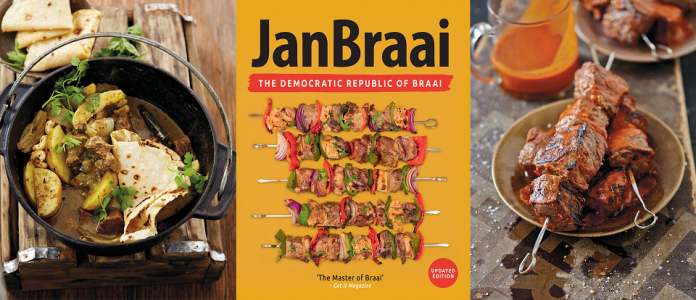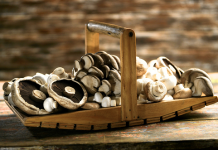This new edition of Jan Braai’s cook (or should we say braai) book features a selection of new recipes, new organisation and a new cover to stand out on the shelves.
Most South Africans know exactly who Jan Braai is – the man who started National Braai Day, and continues to impress with delicious recipes, all done over a ‘lekker’ braai.
With his updated book, choc-full of mouth-watering goodness, he wants to make it known that “it is your democratic right to eat properly braaied food. The Democratic Republic of Braai is wherever you gather around fires with friends and family for a celebration of the nation. Where conversations are had and stories are shared. It is a place where you never have to suffer from badly braaied food.”
It’s the ideal gift for any South African (and just in time to spoil dad for Father’s Day) who loves to cook for friends and family over a fire. Don’t take our word for it, here are two of his new recipes to try this weekend:
Peri-peri beef espetadas
In Jan Braai’s experience the flavour of an authentic homemade peri-peri sauce, in combination with meat, reacts very positively when it is braaied over the coals of a wood fire. Espetada is the Portuguese word for what we usually call a sosatie in South Africa. The traditional espetada ingredients are steak, garlic, olive oil, salt and bay leaves, but we’re going way beyond that here. Technically though, it’s only a sosatie if the marinade was first boiled and then cooled down before using it, so it’s probably more correct to refer to the products of this recipe as espetadas than sosaties. He believes rump steak is the best meat option to use for this recipe, as it’s full of flavour, tender enough for a great eating experience yet tough enough to hold up being marinated in such a robust marinade for a few hours.

What you need (feeds 8):
For the marinade:
8 cloves garlic
a few small hot chillies (preferably African Bird’s Eye)
½ cup oil
½ cup grape vinegar
½ cup lemon juice
½ cup water
1 tot paprika
1 tot chilli powder
1 tot salt
For the espetadas:
2 kg rump steak
8 skewers
What to do:
Marinade:
- Finely chop the garlic and chillies. Put them in a non-reactive container or resealable plastic bag with all the other marinade ingredients and mix well.
- Cut the rump steaks into cubes of about 3 cm to 4 cm but this is not an exact science. To be able to cut blocks that size, remember you need to buy steaks at least that thick so go for the thickest steaks on the shelf or ask your butcher to cut the steaks 4 cm thick.
- Add the cubes of rump steak to the peri-peri marinade. Toss them around a bit so that all the surfaces of all the pieces of meat are well coated. Now let the meat marinate in a fridge for 2 hours. The marinade is quite strong so that will be long enough.
Make the espetadas:
- Divide up the number of cubes evenly and skewer the meat on 8 skewers.
- Braai the espetadas for about 8 minutes over very hot coals until medium rare, turning them about 4 times during this stint on the grid.
- While the meat is braaing, boil the remaining marinade in a small pot or pan over the fire or on a stove. You must let the marinade boil properly, as there was raw steak in it and we want to use it as a sauce.
- Pour the hot boiled marinade, which is no longer a marinade but a sauce, over the braaied espetadas and serve.
Massaman beef curry potjie
The massaman flavour combination has been around for centuries and has truly stood the test of time. It’s traditionally and best made in a potjie on the fire, and it’s made with beef, as opposed to chicken, lamb or pork. Think of it as a combination of a Thai and Indian style of curry.
Characteristically you first make the massaman paste, then fry that in coconut cream, and then you add the meat and potatoes. This is the most complex curry potjie recipe in this book but well worth the effort. The results are quite phenomenal. Jan Braai likes to use a cut like chuck steak for this meal as it has a lot of flavour, can stand up to cooking for a while, and the intramuscular fat means the meat does not dry out too much. For him a cut like rump becomes too dry and something like oxtail takes prohibitively long to become tender.

What you need (feeds 4):
1 punnet fresh coriander (30g)
½ cup salted cashew nuts
4 cardamom pods (whole)
4 cloves (whole)
1 tsp coriander seeds
1 tsp cumin seeds
1 tsp ground nutmeg
1 tsp ground turmeric
1 tsp chilli powder
4 cloves garlic (peeled)
ginger, equal in volume to garlic (peeled and sliced)
1 tsp coarse sea salt
1 tsp olive oil
1 tin coconut cream
1 kg chuck steak meat (deboned and cut into cubes)
1 cup chicken stock
2 bay leaves
2 star anise
2 cinnamon sticks
1 tsp fish sauce
1 lime (juice and zest)
1 tot brown sugar
2–3 medium potatoes (500g, cut into wedges for looks not taste)
2 red onions (cut into wedges for looks not taste)
What to do:
- Wash the coriander and, without thinking about it too much or being too exact, cut it in half with a single stroke of a knife. Keep one half separate for later and finely chop the other half.
- Put your potjie over the flames and dry-roast the cashew nuts for a minute or two. Nuts burn easily so focus solely on this task when performing it. Remove and set aside for later reintroduction to the meal.
- In the now empty potjie, dry-roast the cardamom pods, cloves, coriander seeds and cumin seeds. Again, don’t multitask. Remove from the potjie. From a practical point of view, you might need to use your leather welding or braai gloves to tip the potjie and scrape the spices out as they are too small to simply get out with your wooden spoon.
- Crush open and peel the cardamom pods from step 3
- Discard the shells and add the insides of the cardamom pods and the rest of the dryroasted spices to your pestle and mortar or food processor. Start working them over, also adding the nutmeg, turmeric, chilli powder, garlic, ginger, salt, oil and the chopped coriander from step 1. Continue grinding away until you have a thickish paste. Give yourself a pat on the back – you have now made your very own ‘massaman curry potjie paste’ (MCPP).
- Please note that you can perform steps 1 to 4 even a day ahead of time, should you wish.
- Get the potjie back on the flames and add about 2 tots coconut cream. Now fry the MCPP from step 4 in it for a minute or three.
- Add all of the beef cubes and toss around, stir-frying for a few minutes to get bits of them seared. Don’t overthink this step; get some searing done and move on to the next step. We’re looking at roughly 5 minutes.
- Now add the rest of the coconut cream and the chicken stock and stir well. Use the juices to loosen anything that might be stuck to the bottom of the potjie.
- At this point add the bay leaves, star anise and cinnamon sticks. Bring the potjie to a gentle simmer and put the lid on. Leave it to simmer very gently for 1 hour. You want a few coals under the potjie and a few coals on the lid as well.
- Lift the potjie lid, stir in the roasted cashew nuts from step 2, the fish sauce, lime juice and zest, and sugar. Also add the potatoes and onion and close the lid. Simmer until the potato wedges are soft, which will take about 20 minutes.
- Remove the lid and now let the potjie simmer uncovered until you are happy with the consistency of the sauce.
- Serve with basmati rice or roti.
The Democratic Republic of Braai (Updated Edition) is available in all good bookstores and online.






